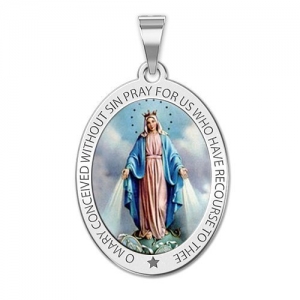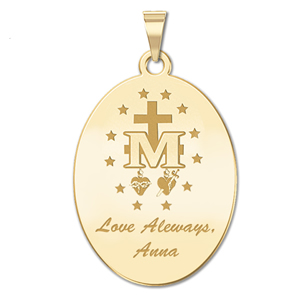C. Anderson wrote: |
|
Hi, guys —
I've been trying to find answers to a few questions for years but have had no success.
- Where the Miraculous Medal states, "Pray for us who have recourse to Thee." who is meant by "us"?
- Does it mean everybody who believes, or only baptized Catholics?
- Is it considered wrong for a person who is not a baptized Catholic, but believes, to wear the Miraculous Medal?
It would be very helpful if you could answer these questions.
Thank you.
C. Anderson |
| { Can you explain what this phrase means on the Miraculous Medal and is it wrong for a believing non-Catholic to wear this medal? } |
Bob replied:
|
Dear friend,
Thanks for the questions.
The expression (as you outlined) refers to all who turn to the Blessed Virgin Mary for help. It is basically "those of us who are turning to you for help."
A non-Catholic can wear the Miraculous Medal; however, it is not magic. The Medal is a sacramental, a visible sign of a spiritual reality which, in this case, is a devotion and consecration, of a type, to the Blessed Virgin. In other words, it represents those who entrust themselves to Mary's care; they accept her spiritual motherhood and all the benefits thereof. Mary makes promises to those who wear the medal because that is a sign of their connection to her care.
The medal would be meaningless if one was unwilling to accept Mary's spiritual motherhood.
So, if a non-Catholic wears the medal, presumably, they accept the Blessed Mother, which is a good thing. They may not be Catholic because they are truly ignorant of the true teaching of the Church, so they haven't really rejected Catholicism per se, but rather a false rendition of it. In other cases, someone may not have been invited to become Catholic but had they received the invitation, they surely would have. Only God knows the heart fully and can sort out who is with Him or not, but anyone willing to accept something of our faith that can bring them closer to the truth and Christ should be encouraged to do so.
Peace,
Bob Kirby |
Mike replied:
|
Dear C.A. —
I can't add any more to Bob's fine answer but seeing this is a medal I just started wearing, I thought non-Catholics unfamiliar with the Miraculous Medal would be interested in what it looks like. This is a higher quality medal but you can get others, as I did, at a much cheaper price.
 |
 |
The Apparition
It began on the night of July 18, 1830, when a beautiful child, dressed in white and emanating heavenly light, awakened a young Daughter of Charity novice, Catherine Labouré, from her sleep. She followed him to the Chapel, where all the candles were lit, as if for midnight Mass. After hearing something that sounded like the rustling of a silk dress, Catherine saw a beautiful woman walk in and sit on the chair used by the director of the community. She remarked,
"I went closer and, throwing myself on my knees, rested my hands on the knees of the Blessed Virgin. At that instant, I tasted the sweetest joy of my life—a delight beyond expression."
The next time Mary appeared on November 27, 1830, she was standing on the world with her feet crushing the head of a serpent, with a "globe in her hands. Her eyes were lifted up to Heaven, and her countenance was radiant as she offered the globe to Our Lord." Then, Catherine saw that Mary had rings of precious stones on her fingers. Rays of light beamed from the stones enveloping Mary "in such a dazzling light that I could see neither her feet nor the robe. …It is beyond my power to give an idea of the beauty and magnificence of the rays."
During this apparition, Mary told her that the rays symbolize the graces that she bestows to all who ask for them. The stones that shed no light represent the graces that people forget to ask for. Then an oval appeared around the Blessed Mother, with the words,
"Mary, conceived without sin, pray for us who have recourse to thee."
Catherine heard the words,
"Get a medal struck after this model. Those who wear it when it is blessed will receive great graces, especially if they wear it about the neck. Graces will be abundant for those who have confidence."
Then the image turned, and Catherine saw the letter M, intersected at the top with a cross and a bar. Underneath were the hearts of Jesus and Mary with twelve stars surrounding the entire image. |
Hope this helps,
Mike
|
|
|
